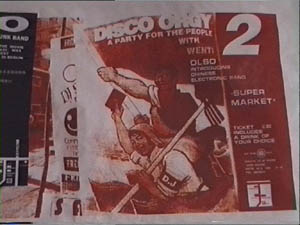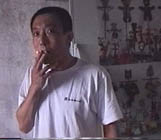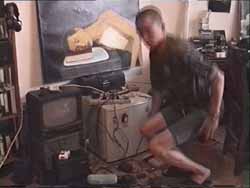 travel
notes
travel
notes travel
notes
travel
notes
some written on the overnight train to Shanghai from Beijing,
others back here in Canberra or wherever/ assorted spots

***
the artist, a painter, who refused to allow us to compare his work to software landscapes. "these are the landscapes of my mind, produced after many hours of meditation, describing the world as an illusion"
***
one artist 's works on tibet. how artists in a country can be used
by the state to naturalise the incorporation or annexation of another people,
albeit with some regret or lament on the behalf of the artists (for example,
white artists and aboriginal culture as officially sanctioned methods/ways/channels
for state mourning)
also then, following this, how the Chinese state neither confirms or
denies the existence or work of the contemporary "unofficial" artists we
have seen, but by maintaining this position, sanctions their work on an
international cultural diplomacy level. The state does not even need to
try, or need to market the work internationally (unlike Australia) as there
is such a demand for it, both at the commercial level and the biennale-type
circuit.
I don't even think it is 'turning a blind eye' to the existence and the on-going production of the work -- it is more that the work is a valid part of china's move into the world. China provides no funds for these artists to live or survive, it is purely the international market which keeps them going/dictates the production of these works (unlike the 'official' artists in China who are provided a wage and other benefits).
These 'unofficial' artists themselves know the limits and work within
these. maybe it is the case that the works are coded in ways that the outsider
can never hope to understand. Clearly however the artists are working firmly
within the frame of 'Chinese identity' which brings me to the question,
when is a Chinese not a Chinese? can a Chinese person ever (hope to) become
un-chinese (why would anyone want to, another question, of course). What
is the lure of the motherland? what are the limits to Chinese identity,
after which one becomes other to it? Such questions are at the heart of
all constructions of national identity, but have particular reverberations
in the Chinese case, given the cultural diversity and realpolitik of the
global diaspora, and, on the other hand, given the number of independent
peoples China claims as its own.
there is/there will be One China
***
after being in the US media CNN space with the china visit of Clinton for even one week, coupled with the amount of MSG in the food, I am feel that I am hallucinating constantly.
***
we are there at the same time as the Clinton visit. State chinese media
space -- newspapers and state television -- very strange to an outsider.
I see for the third time that day Clinton's address to the students, at
least, the question and answer part of it. the chosen students -- party
members and believers -- give him a difficult time over the US position
on Taiwan, human rights and wealth disparity in the US etc. he handles
it so well, he charms them.
During the visit to China he states that yes, Tibet is part of China,
as is Taiwan.
***
Further to the idea that the state neither knows are cares what its artists do on the international stage is the idea of the motivation of the western art market's hunger for this work as the work of 'dissidents'. Over and over in western art/film/video festival catalogues etc we hear that a work was 'banned in china' etc when it is not so much banned as just not existing ie no places to show the work, no public screenings, no infrastructure, the expense of hiring gallery space etc
***
Tuesday 7th
The Friendship Club of the Shanghai Overseas Friendship Association.
last night went to the Friendship Club.
B. had discovered this building during the day (he was beginning to obsess over anything with the word “friendship” in it) and after dinner we were walking along Nanjing Road so had another look.
The dancing in the ballroom was in full swing, with a dance band and a crooning singer. I recognised the singer from a segment on 'Race Around the World' on ABC television. he is around 70, and reputably has a 20yr old wife. This is kind of what my cousin had told me about -- the ballroom dancing Chinese. She had said that often, in recent years in Shanghai, on small backstreets etc you would come across groups of people just waltzing around in the street.
The Friendship Club dancers were good, taking their steps and roles seriously. they were all ages, with more women than men. The men danced with lots of the women, it was indeed friendly. Sometimes the women danced together. Curiously of course B. and I did not know how to dance, (the lumbering westerners). In this, the Friendship Club world, the women were led.
When the music stopped a set, the dj took over, playing eurotrash with a big hard blam blam beat. the people had no idea, doing their tame and polite moves but seeming still to have an excellent time. A younger group took to the techno. later the dance band came back for another set, minus the crooner, swing, very pleasurable
It was a kind of fantasy land. Probably not much dancing was done like this in the heady 60s or 70s -- to the tune of the cultural revolution this would have seemed entirely flimsy and decadent.
the body memory slotted easily back to the forbidden rhythms of the waltz and the samba, but never knew the twist or the bus-stop..... the entire western 60s and 70s musics of pop, rock, funk and disco would have been absent -- there would be no body memory of these rhythms. so the postmodern eurotrash pastiche of haphazard referencing would have no referent here, would be pure rhythmic jumble without source, without history, just like the current culture of new buildings, cars and highways
(as Dutch architect Rem Koolhaas would say in the Pearl River Delta project, these are growing cities of exacerbated difference)
***
a post to australian email list recode, post-china
yeah . I was recently in china, meeting lots of artists, mainly in
Beijing. We were having coffee with three artists and the curator mr
huang du after having looked at these artists' video works (one, Zhu
Jia, is one of the four <media> artists who will be in
the Sydney biennale, and artist Li Yongbin will be in another show
at
gallery 4A in sydney's chinatown in sept, curated by Huang Du. Li Yongbin
mentioned the name of Pauline Hansen -- he knew of her as anti-asian, so
this has been reported in the rather closed chinese media, though the election
result in Queensland was still being run as a segment on cnn weeks after
the election.
my friend pointed out to yongbin that pauline hansen hates artists,
that
she would hate someone like me (us) -- those interested in/working
towards a particular 'politics of' culture -- that it wasn't just
asians
she was on about... this I think came as a suprise to them, so we talked
a lot more about where the support comes from, that it is a global
phenomenon, the right is on the rise everywhere (with local
characteristics). I introduced the concept of 'rednecks’, clearly
translatable with its bodily code, they said there were many new
money and no money 'rednecks' also in china etc
an artist called Zhao Bandi (coming here for the biennale), mainly a
painter with some photoshop interests, showed a work which, at the
end
of a long day of talking with artists, really jumped out at me.
It was kind of night street scene crowded with neon advertising signs,
logos etc, photographed and then reworked in photoshop. everything
was
normal, but he had substituted one of the neons with the slogan, NEVER
FORGET CLASS STRUGGLE. It was so strong, and my friend and I were
excited and really talking a lot about it, as if it were a heavy irony,
but i noticed that the artist, the translator and mr huang du were
very
very quiet, kind of sad and reflective.
then the reason become clear, they talked about how this slogan was
one
which they would have written as children in their note books over
and
over again, and how they would have to repeat it (and many others)
over
and over again. the three people were at school at the tail end of
the
cultural revolution and the beginning of 'open door'.
It was an example to me of the utter complexity of reading images in
a
cross cultures/cross politics/cross time histories, and also of how
one
may "know" the history of a place ie "life in the cultural revolution
was like this etc etc" but never fully or even begin to comprehend
the
reverberations of the personal histories within 'the big picture
politics'
***
notes , Canberra
24 August 98
Russian theorist Lev Manovich writes, in the essay Towards a Cultural Interface "In the 1980s many critics have described one of the key effects of 'post-modernism' as that of spatialisation: privileging space over time, flattening historical time, refusing grand narratives. Digital media, which has evolved during the same decade, accomplished this spatialisation quite literally".
spatialisation may be the postmodern digital condition, but chinese artists are not yet there. they are still in time, deep time. china is not yet wired (up) though are getting there fast -- see Internet section, and its artists, the 'unofficials', particularly some of the artists who are working with video, are working with time, not space as such. and chinese time at that.....
it is the time, and the rhythm of this deep time, that you get a sense of in india and europe. and also if you listen carefully to the land in australia
it is the from this time that the people in china would view the current floods ravaging the country, affecting one fifth of the population (and that's over 200 million people) as a sign from the dragon, or at least, one of the dragons, the gods of the waterways.
it is the strange and deep animism which lives on through the culture, the religion mao was so suspicious of, so keen to cut out of china in the lust for a modern state, the deep deep sense of history as an endless cycle, and the safe place of the individual within the collective body of the people within that.
see contemporary installation and video art in contrast to the recent painting: the gawdy school, the political pop of the 80s/90s -- 2D
see china.wet/ware
for more concise info on video /time etc
the possibility offered by video which contemporary (western) artists
no longer really work with -- that is, the element of time, and realtime
at that. Chinese artists do not have access to digital suites, fancy software
packages etc
all these artists really have is the camera and a small amount of tape
-- they all seem to shoot the original on SPbetacam so the master tapes
are good quality
there is also none of the barrage of the televisual which has so affected the rest of the world. the ads and home shopping channels which have just been beginning in china are kind of flashy and quaint.
also they are without the multimedia explosion of the information age. However, not for long as a trip to Beijing's Haidian computer district confirms. see internet
so the works, in their kind of basic manner are not antimedia, it is more that there is very little media as such (as in the west)
all in real time, means of production issue -- no access to editing facilities, so the works are like documentation of performed real events. editing costs are completely exorbitant.
***
Zhang Peili -- a kind of visual cubism.
time -- the way the image disintegrated via technical means was the
subject of one installation. he had a sequence of a street scene, and had
shot and reshot it again and again, shooting the monitor , then playing
this decayed image on the next monitor , then doing the same again, and
again for about eight monitors, so that the final image was very decayed.....beautiful.
(see Huang Du's catalogue essay of this work) -- working with time/decay-over-time
via technical means
other works--
the newsreader who read on and on all the derivations of the chinese
word for water, on and on..
multiple perspectives in real time on the same event ie throwing
a ball and catching it (repeatedly), or the three monitor work we will
see in the biennale, 'eating'
Song Dong installation -- his family is projected onto a wall and one
steps into the space of one of the phantom figures to become ...what?
A photo is then taken. this is the document of the work.
I liked very much an idea which came from out of a conversation with
Song Dong about Confusianist idea of the cart, the horse and the man doing a task.
the man does not exist anymore, but in encompassed by the cart and the
horse. all three are all three


Li Yongbin -- faces
all real time, lonely solitary performances, a person confronting their
existence, all shot inside
the face of an old woman projected onto Yongbin's face

Zhu Jia -- again, no editing, or I think just in camera. all works
playing with point of view of camera
biking through beijing -- the camera attached to the bicycle wheels
as the bike rides through the city , round and round the image goes, slowing
down and speeding up with the traffic flow/s
fridge -- the camera inside the fridge (playing with p.o.v.)
the fish (loop).
in this work a fish is flipping around, dying, out of water.
contrary to a western desire for closure and some kind of 'statement' Zhu
Jia does not give us an ending. the fish is looped dying over and over
again, but still flipping. Zhu Jia does not give us the tidy “earth is
dying, the environment is ruined, fish are dying etc” line, instead speaks
more to the circularity of things, the endlessness of history, life and
lives; on and on
Qui Zhi Jie--
excellent documentary on ping pong, and how this game historically
has signified changes to domestic and foreign policy in china
the work in the Vivre exhibition (French curator, Christine Kayser,
Beijing, June 1998) had been edited in some way, it was a kind of rambling
sequence of images, which included various figures from history merged
with a meat slicing machine, and real-estate ads (home ownership has just
become possible for the bulk of chinese with the first IKEA shop just
opened in Shanghai
***
unlike in the west,where many media artists come to the practice from a diversity of backgrounds (media, computers etc) in China most of the artists I met using video seems to have classic training/artschool backgrounds.
only one of the video artists I met did not have an artschool background. Zhao Liang. His work was clearly very different from the other video artists -- the film school background shows. his work is narrative based in a way that the other work was not at all. it is also edited. in a really lovely, rhythmic manner. he was the closest we met to a punk.

Feng Mengbo -- who I didn't meet, but who works with computers. I always thought the title of one of his CDROM works 'Taking Tiger Mountain by Strategy' was just the name of a Brian Eno album. Only recently did I find out it is a Chinese opera.
Zhao Bandi -- the panda, the 'never forget class struggle' work (photoshop
-- he takes the ideas to a desktop publishing place, sits with them while
they scan in the images he wants and manipulates them as he wants..)
it is absolutely about memory, and words written on the body of the
mind.
Critic Huang Du speaks about these and other artists ars exhibiting 'individualism with chinese characteristics' . Exactly what these 'chinese characteristics' are becomes the issues.
Chineseness as both a genuine component of the work, but also as their
guarantee ie what can be constructed as loyalty to China enables these
artists to be relatively free from state interference, then so be it
also 'chineseness' is the thing which is so desirable on the western
art circuit
art as everyday life runs the risk of becoming art as anthropology
Two of the artists featured in the Biennale are from Beijing, Zhu Jia
and Zhao Bandi. Zhang Peili is from Hangzhou.
***